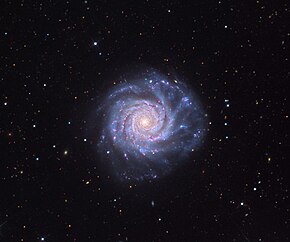Loading AI tools
Galaxy in the constellation Ursa Major From Wikipedia, the free encyclopedia
NGC 3938 is an unbarred spiral galaxy in the Ursa Major constellation. It was discovered on 6 February 1788 by William Herschel. It is one of the brightest spiral galaxies in the Ursa Major South galaxy group and is roughly 67,000 light years in diameter.[3] It is approximately 43 million light years away from Earth.[1] NGC 3938 is classified as type Sc under the Hubble sequence, a loosely wound spiral galaxy with a smaller and dimmer bulge.[4] The spiral arms of the galaxy contain many areas of ionized atomic hydrogen gas, more so towards the center.[5]
| NGC 3938 | |
|---|---|
 | |
| Observation data (J2000 epoch) | |
| Constellation | Ursa Major[1] |
| Right ascension | 11h 52m 42.9s[1] |
| Declination | +44° 07′ 17″[1] |
| Distance | 43 Mly |
| Apparent magnitude (V) | 10.9[1] |
| Characteristics | |
| Type | SA(s)c[2] |
| Apparent size (V) | 5.4′ × 4.9′[1] |
| Other designations | |
| UGC 6856, MCG +07-25-001, PGC 37229[2] | |
Five supernovae have been identified within NGC 3938. SN 1961U (mag. 13.7) was discovered on 2 January 1962.[6] SN 1964L (mag. 13.3) was discovered on 11 December 1964.[7] SN 2005ay is a type II supernova that was discovered on 27 March 2005 and had a magnitude of 15.6.[8] SN 2017ein is a type Ic supernova that was discovered on 25 May 2017 and peaked at magnitude 14.9.[9] Images taken before the explosion point to a progenitor mass between ~47-48M☉, if it was in a single star system, and ~60-80M☉, if it was in a binary star system.[10] SN 2022xlp is a type Ia supernova that was discovered on 13 October 2022 by Kōichi Itagaki.
Seamless Wikipedia browsing. On steroids.
Every time you click a link to Wikipedia, Wiktionary or Wikiquote in your browser's search results, it will show the modern Wikiwand interface.
Wikiwand extension is a five stars, simple, with minimum permission required to keep your browsing private, safe and transparent.